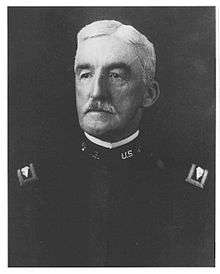Rogers Birnie
Rogers Birnie (5 April 1851 – 25 September 1939) was a United States Army officer and explorer of Death Valley.
Rogers Birnie | |
|---|---|
 | |
| Born | 5 April 1851 Taneytown, Maryland |
| Died | 25 September 1939 (aged 88) Washington, D.C. |
| Allegiance | United States |
| Service/ | |
| Years of service | 1872–1915 |
| Rank | |
| Battles/wars | Spanish-American War |
| Relations | Ernest Graves Sr. (son-in-law) Ernest Graves Jr. (grandson) |
Biography
Rogers Birnie was born in Taneytown, Maryland,[1] on 5 April 1851.[2] He grew up in Gettysburg, Pennsylvania, and could hear the guns from his house during the Battle of Gettysburg during the American Civil War. He graduated first in the West Point class of 1872, and immediately went out west to Fort Douglas near Salt Lake City. He joined the Wheeler Survey in 1874. During the survey, He found some Anasazi ruins which in the 20th century were made a UNESCO world heritage site. In 1875, he led an expedition from Los Angeles, over the San Gabriel Mountains, and through the Mojave Desert. During that same expedition, Birnie did the first scientific exploration of Death Valley before climbing Mount Whitney. He was one of the co-founders of the National Geographic Society in 1888, where he served as the first manager of the board of directors. He was an ordnance officer in Cuba during the Spanish–American War, and was a civilian consultant to the army in world War I. He died in Washington, D.C., on 25 September 1939.[1]
References
- "A Historic Journey Into Death Valley". National Geographic Society. 20 July 2012. Retrieved 6 October 2019.
- Cullum, George W. (1930). Biographical Register of the Officers and Graduates of the US Military Academy at West Point New York Since Its Establishment in 1802: Supplement Volume VI-A 1910–1920. Chicago: R. R. Donnelly and Sons, The Lakeside Press. p. 167. Retrieved 6 October 2015.CS1 maint: ref=harv (link)